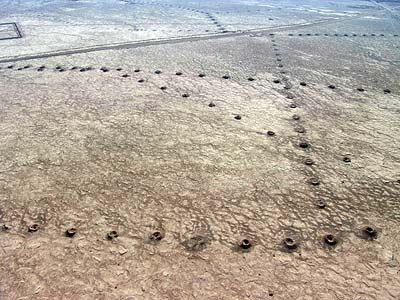 رشته هاي قنات ها در حاشيه شهر يزد. Qanats strings in margin of Yazd city. مهدي خبره دست Preliminary considerations indicated that the precious verbal knowledge of the qanat practitioners enjoys some very considerable scientific points applicable to the current hydraulic expertise as well social issues worthy of documentation. Needless to say acquaintance with qanat construction technology necessitates the interpretation of the local terms concerning the issue. Thereupon, we decided to document the qanat practitioners` invaluable know-how so that the present and the coming generations can have access to a lasting reliable source.
This book is edited on the occasion of «UNESCO»`s approval concerning the establishment of an «International Center on Qanats and Historic Hydraulic Htructures in Iran» under its auspices.
Due to the shortage of time, I didn`t find the opportunity to translate the whole book into English. Nevertheless, I translated the introduction and a summary in order to be available to the international experts. I hope I would be able to accomplish the full translation in the near future.
I wish that this edition would be useful to students, researchers, experts and all those who are interested in qanat studies.
Outlook
This study deals mainly with the qanat distinguished background across the province of Yazd in Iran. The used methodology can be applicable to other provinces of Iran enjoying of these ancient and sustainable hydraulic structures. Countries benefiting form these traditional hydraulic structures can adopt the same method as well. The concerned methodology is also applicable in other fields of activity such as groundwater reservoirs, wind towers, water mills, ancient mansions, public bathhouses, etc. Nevertheless, this process seems to be the best policy for the documentation of the knowledge handed down by the practitioners.
Conclusion
This edition was the outcome of three years of constant work coupled with accuracy and scrutiny, yielding the following results:
1- Gathering and compiling the technical and management issues from the traditional qanat experts` viewpoint. This know-how was documented for the first time in order to keep this cultural intangible legacy.
2- Finding a meaningful correlation between the traditional experts` viewpoints and the modern sciences so that the traditional know-how can complement the new scientific findings, and the modern science confirms the traditional knowledge on the other hand.
3- The knowledge which was once handed down from father to son verbally has been documented now to benefit the coming generations.
4- Acquaintance with qanat traditional terminology to better maintain and rehabilitate this system.
5- Applying the methodology to the other provinces of the country in order to document the traditional knowledge there.
6- Applying the methodology to the other historic hydraulic structures such as water reservoir, watermill, public bath, aqueduct, dam, etc in order to document the traditional knowledge about their architecture and function.
We hope this cultural effort would meet the expectation of the enthusiastic scholars, students and especially the water sector experts.
Ali Asghar Semsar Yazdi | 
